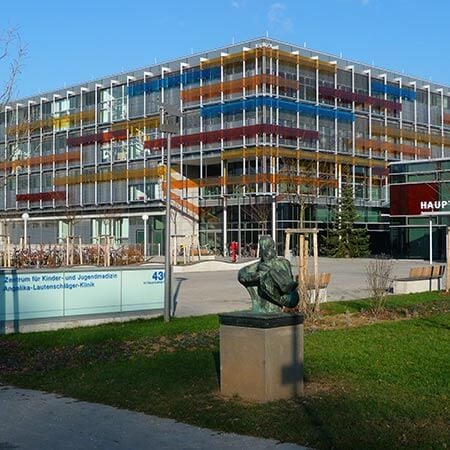Content
- Soft tissue sarcomas
- How soft tissue sarcomas are treated?
- Fibrosarcoma overview
- Fibrosarcoma types
- Examination of children with fibrosarcoma
- Treatment of fibrosarcoma
- Chemotherapy for fibrosarcoma
- The treatment of infantile fibrosarcoma in European hospitals
- The cost of treatment abroad
- Treatment abroad with Booking Health
Children with malignant tumors occurring during the first year of life make up 0.5-2% of the all cancer cases detected in childhood. Pediatric fibrosarcoma is cancer usually occurring in children during the newborn period. According to researches, pediatric fibrosarcoma accounts for almost 24% of all soft tissue sarcoma cases, occupying 2nd place in the structure of soft tissue cancer after rhabdomyosarcoma.
Soft tissue sarcomas
Soft tissue sarcomas are a group of malignant neoplasms that develop in muscle, fat, connective, or fibrous tissues. Soft tissue sarcomas can develop anywhere since the tissues of origin are present in most parts of the body. However, soft tissue sarcomas are most often detected in the upper and lower limbs.
Such cancer manifests itself with a painless node or insignificant swelling. The neoplasm often has clear boundaries, but if the malignant focus lies deep, the boundaries of the neoplasm can be blurred and difficult to determine. The skin over the soft tissue sarcoma is virtually no different from healthy skin.
With the growth of soft tissue sarcoma, dilated veins and ulcerative lesions often arise. Discomfort may occur during movement, although the severe violation of the limbs function is not observed.
Soft tissue sarcomas look like white-gray nodes. By consistency, soft tissue sarcoma can be soft (liposarcoma) or dense (fibrosarcoma). Having no nuclei, the soft tissue sarcoma is inclined to provoke the increased density of the surrounding tissues as it grows, which determines formation of the clear tumor boundaries. Most often, the cancer process is isolated, but there are exceptions. Soft tissue sarcomas metastasize by hematogenic way (through the bloodstream).
How soft tissue sarcomas are treated?
In the treatment of soft tissue sarcomas, complex techniques are used, including surgery, chemotherapy, and radiation therapy. The soft tissue sarcoma is usually excised with some volume of the surrounding healthy tissue. To reduce the size of the soft tissue sarcoma before the operation, chemotherapy and radiotherapy are applied.
An integrated approach to the treatment of soft tissue sarcomas makes it possible to improve the quality of life of adults and children with cancer. With timely treatment, a large percentage of patients with soft tissue sarcomas achieve complete recovery and return to the usual lifestyle. For a successful outcome, it is very important to choose competent specialists who have vast experience in the treatment of different types of soft tissue sarcomas.
Fibrosarcoma overview
Consisting of immature fibroblast-like cells, collagen fibers, or other structures of fibrous tissue, fibrosarcomas belong to the group of soft tissue sarcomas.
Differentiation of fibrosarcomas should be carried out by an experienced specialist since this malignant tumor is very difficult to distinguish from other soft tissue sarcomas. Most often, the diagnosis of fibrosarcoma is established by the exclusion method, after excluding the diagnosis of other clinical conditions.
Fibrosarcoma is diagnosed less often than other similar cancer subtypes. Previously, any sarcoma containing fibroblastic cells was automatically considered fibrosarcoma. Therefore, this subtype of cancer accounted for more than two-thirds of all sarcoma cases. In recent years, due to the development of new effective ways of clinical diagnosis making, such as immunohistochemistry and cytogenetics, this diagnosis is established more accurately and correspondingly less frequently.
Fibrosarcoma types
Generally, fibrosarcoma is formed from connecting tissue fibers that have a minimal degree of differentiation. According to statistics, this disease is most common in female patients. Cancer may affect any skin area, but the distal sections of the legs is the most frequent localization. Fibrosarcoma may also develop on the head, torso, and shoulders.
Children with fibrosarcoma can have a tumor of three types: myofibrosarcoma, infantile fibrosarcoma, and congenital infantile fibrosarcoma.
Myofibrosarcoma is a pathology found in children, and very rarely in adults. It is also uncommon to diagnose such fibrosarcoma in older children. It can be localized close to the brain, part of the skull, and neck.
Children with infantile fibrosarcoma are usually under the age of 5 years. Moreover, the greatest risk of tumor development is present during the first year of life. Infantile fibrosarcomas grow rapidly, but discomfort or symptoms are virtually absent. They are most often localized on the neck or limbs. Congenital infantile fibrosarcoma has all the same features, except that children may be already born with this type of cancer.
Some other forms of cancer are unique in terms of biological features. An example could be the Ewing sarcoma, which is considered a highly differentiated type of fibrosarcoma. Also, the sclerosing epithelioid fibrosarcoma has some features inherent in the most common forms of cancer, which may impede the differential diagnosis of the type of tumor.
Examination of children with fibrosarcoma
Modern medicine uses a number of diagnostic methods that make it possible to reveal tumor growth. First of all, it is necessary to collect anamnesis of children with fibrosarcoma and learn whether this is the first case of the disease in the family. Next, during the examination, various procedures are performed, allowing to assess the health condition of children with fibrosarcoma properly.
The specialist uses one or more diagnostic methods such as:
- Ultrasound scan (allows identifying the location of the tumor and determines the condition of the internal organs)
- MRI and CT scan (make it possible to assess exact shape of the neoplasm, its boundaries and relation to the nearby structures, as well as detect metastases)
- Biopsy (allows accurate determination of the fibrosarcoma type and influences the therapy choice in children with fibrosarcoma)
It is possible to use several diagnostic methods at once, which will allow getting a clearer picture and developing the treatment tactics for children with fibrosarcoma.
Treatment of fibrosarcoma
Generally, surgery is considered one of the most effective treatment options for children with fibrosarcoma. However, some types of soft tissue sarcomas, including fibrosarcoma, may be quite difficult to remove completely. In finding a tumor on the limb, for example, the part of the skin where it was localized may be removed. If the disease affects large blood vessels, specialists can offer an amputation of the limb, but it is offered only as the last-line therapy.
Well, apart from that, the most frequent treatment for children with fibrosarcomas is surgical tumor removal and subsequent chemotherapy to prevent a recurrence. Symptomatic treatment is also administered in the presence of severe pain syndrome.
Chemotherapy for fibrosarcoma
Chemotherapy in children with fibrosarcoma can be administered as the main or auxiliary treatment (in combination with the surgery), depending on the degree of tumor spreading. As a rule, chemotherapy includes a combination of antitumor medications.
During the course of chemotherapy, tumor cells are destroyed, but the normal cells of the body are damaged as well, which leads to temporary side effects. Children with fibrosarcomas may experience such side effects as nausea, vomiting, the loss of appetite, hair loss, and the formation of ulcers in the mouth. The most severe complication of chemotherapy is the damage to the heart muscle and infertility due to violation of the functions of ovaries and testicles.
The treatment of infantile fibrosarcoma in European hospitals
European hospitals provide services of high-quality pediatric cancer care, comfortable conditions of stay for parents and children while using the most modern and sparing techniques for the treatment of infantile fibrosarcoma in children.
One of the key advantages of the treatment of infantile fibrosarcoma in children in European hospitals is the flexibility of clinical protocols, which makes it possible for the European specialists to use alternative and experimental treatment methods.
In addition, European hospitals gradually shift from the narrowly specialized approach to interdisciplinary cooperation, as many diseases, including pediatric cancer, require the involvement of specialists of different fields of medicine in the treatment process.
European hospitals below are considered leading in the treatment of infantile fibrosarcoma in children:
- University Hospital RWTH Aachen, Germany
- University Hospital Duesseldorf, Germany
- University Hospital Tuebingen, Germany
- Charite University Hospital Berlin, Germany
- University Hospital Hamburg-Eppendorf, Germany
To find out more information about the treatment of infantile fibrosarcoma in children or the services mentioned European hospitals provide, visit the Booking Health website.
The cost of treatment abroad
The cost of treatment abroad is relatively low, given the price level in countries with developed medicine. The rating of countries with developed medicine varies depending on the factors for which they are ranked (the cost of treatment with different methods, the number of foreign patients, and so on).
The full cost of treatment abroad and the prices for medical programs for the particular patient are determined based on the required procedures and medicines, and time of stay in the clinic. Therefore, it is impossible to determine the exact cost of treatment abroad in advance.
However, the average cost of treatment of infantile fibrosarcoma with chemotherapy is in the range of 4,769-12,953 EUR. The cost of treatment with surgery resection is in the range of 9,166-25,592 EUR. The cost of treatment with radiotherapy is in the range of 15,300-34,344 EUR. The price of examination starts at 1,188 EUR.
To get a free consultation on the estimated cost of treatment, leave a request on the Booking Health website.
Treatment abroad with Booking Health
To date, many countries demonstrate good results in the fight against oncological diseases. The use of high-precision clinical equipment, conventional and innovative treatment techniques, the vast experience of oncologists, and their cooperation with other specialists make it possible to achieve favorable results.
Booking Health has extensive experience in the field of medical tourism that allows the company to choose European hospitals that stand out among others for their achievements. With Booking Health, patients have the opportunity to choose the most effective medical services at the most suitable prices.
If you're interested in getting assistance in the organization of treatment abroad, leave a request on the Booking Health website, and a medical consultant will contact you shortly.
Authors: Dr. Nadezhda Ivanisova, Dr. Farrukh Ahmed



















